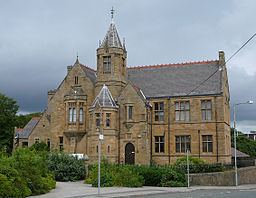Established 1559 Type Grammar school Ages 11–18 | Closed 1981 Gender Male Founded 1559 | |
 | ||
Location Byron StreetBurnleyLancashireEngland | ||
Burnley Grammar School was latterly, a state-funded selective boys grammar School, situated in Byron Street in Burnley, England. However, during its long history, it moved between a number of sites in the town.
Contents
History
In 1552, on the order of Edward VI of England, Chantries were dissolved, effectively closing the Chantry School in Burnley. The lands that had funded the chantry, were purchased by some of the wealthy men of the parish and granted to the former chantry priests for the rest of their lives. This enabled the chantry school to continue to operate for a few more years.
By 1558 it had become obvious that the chatries would not be restored and the men urged the endowment of a Free Grammar School, with additional gifts of land and rents. On the 1 February 1559, the Habergham deed was sealed marking the beginning of a Burnley Grammar School. The Towneley family, along with the Haydock, Habergham, Woodruff and Whitacre's, provided the first founders and governors of the school.
Its first headmaster was a former chantry priest, Gilbert Fairbank, with lessons initially taught at his home next to St Peter's Church (53.792°N 2.240°W / 53.792; -2.240). In 1602, one of the governors, John Towneley, paid for a new schoolhouse to be built in the churchyard.
There was a dispute throughout the 1680s between the Catholic Towneleys and the school’s other, now Anglican governors over the choice of schoolmasters. This resulted in the building in 1693, by the Anglicans of a new schoolhouse (53.793°N 2.240°W / 53.793; -2.240), across the River Brun in an area then known as Brown Hill. In 1728 the Suffolk-based, Burnley born clergyman, Henry Halstead left a large collection of Books to the School’s library.
The school seems to have been in decline in second half of the 19th century, even as the town rapidly expanded around it. An education commissioner’s report from the late 1860s showed attendance to be low and the schoolhouse in a poor state. Wealthy families shunned the school in favour of distant boarding schools, and several attempts to raise funds for a new building failed. During 1871 the Governors of the school agreed to allow the representatives of the Town Council and School Board to join them, in return for financial aid. This resulted in the 1874 opening of new school buildings across Bank Parade (53.793°N 2.241°W / 53.793; -2.241), which can still be seen today. Despite an agreement at this time to establish a girls department once funding could be established, no action was taken. By the late 1890s, it looked like the school board would create a rival higher grade school, which would likely be disastrous for the grammar school. Some girls were allowed to attend from 1903 and it was taken over entirely by the council in 1904. It was decided that an equivalent girls school should be created and Burnley High School for Girls opened in Ormerod Road in 1910 (53.793°N 2.238°W / 53.793; -2.238). It moved to a new building in the former grounds of Ivy Bank House in the 1951 (53.794°N 2.288°W / 53.794; -2.288). In 1959 the grammar school moved once again to larger premises on Byron Street (53.795°N 2.293°W / 53.795; -2.293), neighboring the girls school with Ivy Bank Secondary Modern School also constructed on the site in the 1960s.
The school celebrated an annual founders day at St Peters. During the 70's it had very active Public Speaking & Debating Clubs (Mr JD Mitchell), a Photographic Society (Mr AG Stephenson), Film club (Mr Wardle), French Club (Madam Heap).
Most boys took up to 10 GCE 'O' levels, and rarer subjects including Geology (Mr HH Grieve), Control Technology (Mr Stephenson), Additional Maths (Mr Grayson), Latin, were offered. The school was particularly successful at encouraging boys to read PPP/PPE at Oxford.
The mixed comprehensive Habergham High School was formed in 1981, from the merger of two schools, with the girls school becoming the sixth form centre.
Burnley Grammar Schools last Headteacher being Mr Keith Panter, Mr P Jennings and Mr GD Clayton (Death Notice September 2014) were his deputies. Staff included Mr JD Mitchell (Senior Teacher i/c Library), Mr Mel Saunders (Maths), Mr Bernard Grimes (Chemistry & Head of science), Mr W Slater (Biology), During this period, many new names were considered for the school including 'Burnley Collegiate School' which was deemed to be inappropriate.
In 2006 Habergham merged with Ivy Bank to form Hameldon Community College, which in 2010 moved to a new building on Coal Clough Lane. In 2015 it was announced that the recently opened free school, Burnley High will construct a new building on the former Habergham site.
